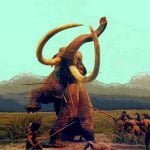Most of the Shenandoah Valley is part of the Ridge and Valley Province that extends from southeastern New York to northwest of Atlanta, GA. The eastern flank of the valley is part of the Blue Ridge Mountains that extend from eastern Pennsylvania to northern suburbs of Atlanta, GA. The Blue Ridge Mountains are composed of igneous and metamorphic rocks. The southern end of the Shenandoah Valley contains also igneous rock outcrops, known as “mow hills” that are the remnants of ancient volcanoes. Most of the valley is underlain by sedimentary or metamorphic rocks that were originally sedimentary.
Early Paleo-Indian Period (15,500 BC? – 10,000 BC)

During the maximum extent of North America’s glaciers during the Pleistocene Geological Period, the Shenandoah Valley would have been similar in appearance to Lapland in northern Scandinavia today. Stunted conifers and birches were clustered around rivers and streams. The bottom of the valley was covered with mosses, grass and hardy shrubs. The mountains were snow-capped for much or all of the year. However, to date no evidence has been found of glaciers. The mountain slopes would have been permanently frozen, rocky and partially covered with moss. At the peak of glacial expanse, sea level was about 360 feet (120 meters) lower than today. Virginia might have extended another 100 miles to the east during that period.
Animals typical of the arctic tundra, such as the musk ox and caribou, inhabited the region during the coldest part of the Ice Age. There were probably small bands of hunters in the Shenandoah Valley at this time, but no evidence has been found.
For almost a century the widely accepted orthodoxy of anthropology was that Asiatic peoples entered North America over a temporary land bridge between Siberia and Alaska around 10-12 thousand years ago and became the ancestors of all American Indians. A series of archaeological and genetic discoveries since 1990 have raised serious doubts as to universal validity of this orthodoxy. One of the most compelling arguments against it is that human beings paddled to Australia at least 50,000 years ago to settle that isolated continent. Currently, there is no consensus for an alternative model for the settlement of the Americas. However, support for the ”one time Siberian exodus” is rapidly fading.
Late Paleo-Indian Period (10,000 BC – 7,000 BC)

A point was reached in the warming process that allowed all the permafrost on the mountains to melt. Geologists have found extensive evidence of massive landslides during the warming period. One section of landslides in the extreme southern end of the Shenandoah Valley contains more than one billion cubic yards of rock, and extends more than 10 miles along Sinking Creek Mountain. Elsewhere, thawed soils sloughed off the upper elevations of the mountains and flowed into the valley. Such landslides along with loess blow into the valley from arid regions to the west would have covered evidence of man’s early occupation of the valley.
Conifer trees began climbing up the slopes of the Shenandoah Valley’s mountain ranges as the climate warmed. The most common species would have been red spruce, balsam fir, hemlock, white pine and juniper. The birch trees along the stream beds probably grew increasingly large, and began to face competition from
When the climate began to warm, more animals associated with northern temperate climates entered the valley. These included the mastodons, mammoths, peccaries, giant ground sloths, primitive horses, giant bison, giant elk, white-tailed deer, giant moose, giant beavers, giant armadillos and possibly llamas. Several species of fishes lived in the rivers; probably also frogs and snakes.
People of the Paleo-Indian Period were hunters and gatherers. Being a location where game was plentiful, the Shenandoah Valley attracted humans very early. Clovis points have been found there that have been dated to about 11,000 years ago. A pre-Clovis site has been identified by archaeologists at Cactus Hill, VA in the Virginia Piedmont. The artifacts at that location have been dated to about 15,500 years ago. Jasper was mined by Paleo-Indians at several locations in northwestern Virginia to make spear points and tools.
There are many caverns and caves in the Shenandoah Valley. One of the most famous caverns in the nation is at Luray, VA. There are poorly documented stories of early settlers finding Native American artifacts and skeletons in caves. The fates of these artifacts are not known.
There was a rather quick extinction of many species of large mammals at the end of the Pleistocene Age. The cause of this rapid die-off is still being debated by archaeologists, geologists and biologists. Traditionally, American Indian hunters were blamed, but some mega-fauna continued to thrive in Africa, Europe and Asia, where human populations were probably denser. Other suggestions have been that bacterial or viral plagues killed off these animals, or that the Southeast was struck by a dense swarm of meteors
